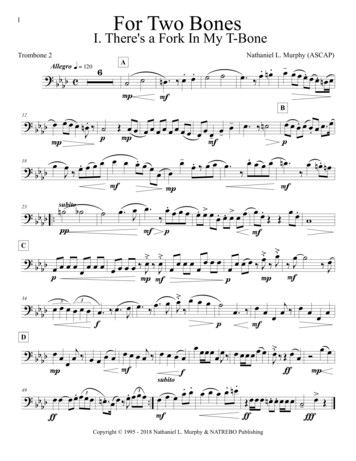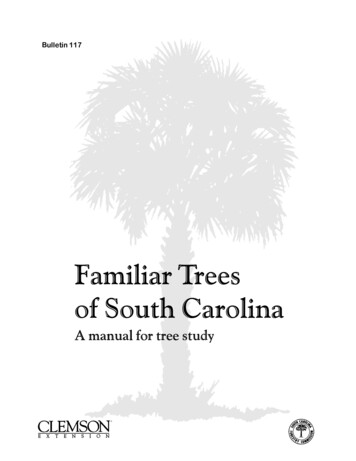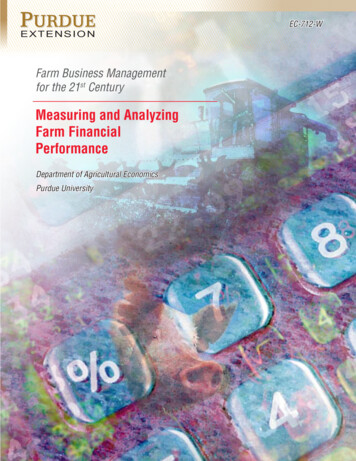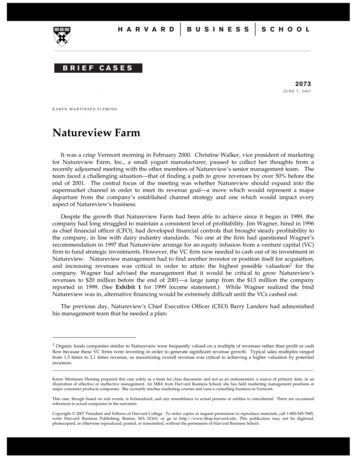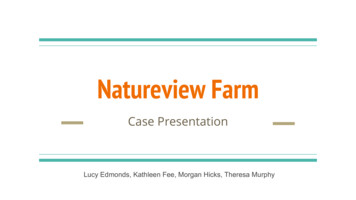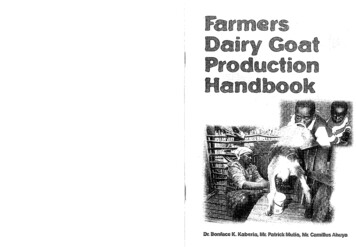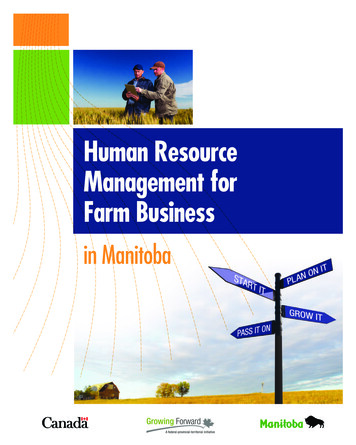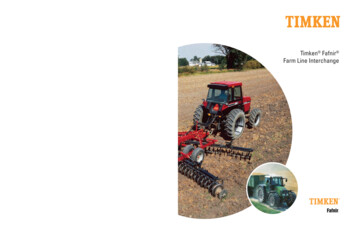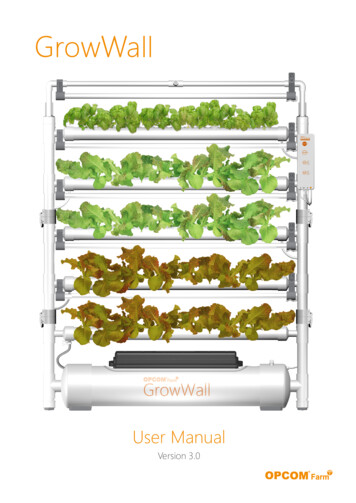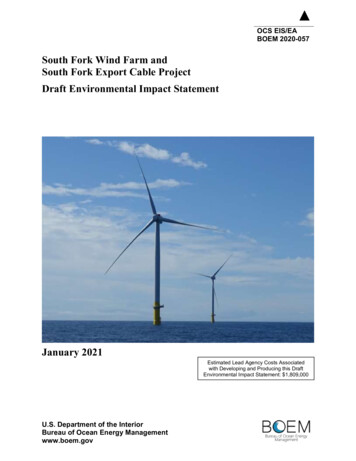
Transcription
OCS EIS/EABOEM 2020-057South Fork Wind Farm andSouth Fork Export Cable ProjectDraft Environmental Impact StatementJanuary 2021Estimated Lead Agency Costs Associatedwith Developing and Producing this DraftEnvironmental Impact Statement: 1,809,000U.S. Department of the InteriorBureau of Ocean Energy Managementwww.boem.gov
This page intentionally left blank.
OCS EIS/EABOEM 2020-057South Fork Wind Farm andSouth Fork Export Cable ProjectDraft Environmental Impact StatementJanuary 2021Author:Bureau of Ocean Energy ManagementOffice of Renewable Energy ProgramsPublished by:U.S. Department of the InteriorBureau of Ocean Energy ManagementOffice of Renewable Energy Programs
This page intentionally left blank.
South Fork Wind Farm and South Fork Export Cable Project Draft Environmental Impact StatementENVIRONMENTAL IMPACT STATEMENTSOUTH FORK WIND FARM AND SOUTH FORK EXPORT CABLE PROJECTDraft (X)Final ( )Lead Agency:U.S. Department of the Interior, Bureau ofOcean Energy Management (BOEM)Cooperating State and Local Agencies:Commonwealth of Massachusetts Office ofCoastal Zone ManagementState of Rhode Island Coastal ResourcesManagement CouncilState of Rhode Island Department ofEnvironmental ManagementTown of East HamptonTrustees of the Freeholders andCommonalty of the Town of EastHamptonCooperating Federal Agencies:U.S. Department of Commerce, NationalOceanic and AtmosphericAdministrationNational Marine Fisheries ServiceU.S. Department of Defense, U.S. ArmyCorps of EngineersU.S. Department of Homeland Security,U.S. Coast GuardU.S. Department of the Interior, Bureau ofSafety and Environmental EnforcementU.S. Environmental Protection AgencyContact Person:Mary Boatman, National EnvironmentalPolicy Act CoordinatorOffice of Renewable Energy Programs,Environment Branch for Renewable EnergyBureau of Ocean Energy Management45600 Woodland RoadSterling, Virginia 20166(703) 787-1662Cooperating Tribal Nation:NoneArea:Lease Area OCS-A 0517Date for Comments:February 22, 2021AbstractThe South Fork Wind Farm and South Fork Export Cable Project Draft Environmental Impact Statement(DEIS) assesses the reasonably foreseeable impacts to physical, biological, socioeconomic, and culturalresources that could result from the construction and installation, operations and maintenance, andconceptual decommissioning of a commercial-scale wind energy project, the South Fork Wind Farm andSouth Fork Export Cable Project (the Project), located in BOEM Renewable Energy Lease Number OCSA 0517, approximately 19 miles southeast of Block Island, Rhode Island, and 35 miles east of MontaukPoint, New York.Deepwater Wind South Fork, LLC, is proposing the Project, which is designed to contribute to NewYork’s renewable energy requirements, particularly, the state’s goal of generating 9,000 megawatts ofoffshore wind energy by 2030. BOEM has prepared the DEIS following the requirements of the NationalEnvironmental Policy Act (42 United States Code [USC] 4321–4370f) and implementing regulations.Once finalized, the final environmental impact statement (FEIS) will inform BOEM in deciding whetherto approve, approve with modifications, or disapprove the Project. Cooperating agencies would rely onthe DEIS to support their decision making and to determine if the analysis is sufficient to support theirdecision. BOEM’s action furthers United States policy to make the Outer Continental Shelf energyresources available for development in an expeditious and orderly manner, subject to environmentalsafeguards (43 USC 1332(3)), including consideration of natural resources and existing ocean uses.i
South Fork Wind Farm and South Fork Export Cable Project Draft Environmental Impact StatementEXECUTIVE SUMMARYThe South Fork Wind Farm and South Fork Export Cable Project Draft Environmental Impact Statement(DEIS) assesses the reasonably foreseeable impacts to physical, biological, socioeconomic, and culturalresources that could result from the construction and installation, operations and maintenance (O&M),and conceptual decommissioning of a commercial-scale offshore wind energy facility and transmissioncable to shore known as the South Fork Wind Farm (SFWF) and South Fork Export Cable (SFEC) Project(Project). The Bureau of Ocean Energy Management (BOEM) has prepared the DEIS under the NationalEnvironmental Policy Act (NEPA) (42 United States Code [USC] 4321–4370f) and Executive Order13807 (Establishing Discipline and Accountability in the Environmental Review and Permitting Processfor Infrastructure).Council on Environmental Quality (CEQ) NEPA regulations from 1978 were revised on July 26, 2020,and took effect on September 14, 2020. Because work on the DEIS began before September 14, 2020,BOEM has followed the 1978 CEQ NEPA regulations. All following citations to CEQ NEPA regulationsrefer to the regulations before they were revised on July 26, 2020 (see 40 Code of Federal Regulations(CFR) 1506.13 of the revised regulations). Once finalized, the final environmental impact statement(FEIS) will inform BOEM’s decision on whether to approve, approve with modifications, or disapprovethe Project’s construction and operations plan (COP).Purpose of and Need for the Proposed ActionOn March 28, 2017, the President determined that it is “in the national interest to ensure that the Nation'selectricity is affordable, reliable, safe, secure, and clean, and that it can be produced from domesticsources, including renewable sources” (Executive Order 13783:Section 1(b)).Through a competitive leasing process under 30 CFR 585.211, Deepwater Wind New England, LLC wasawarded Commercial Lease OCS-A 0486 for a leased area offshore Rhode Island. This lease area waslater assigned to Deepwater Wind South Fork, LLC (DWSF) and segregated to Commercial Lease OCSA 0517 (Lease). DWSF has the exclusive right to submit a COP for activities within the area of the Lease,and it has submitted a COP to BOEM proposing the construction and installation, O&M, and conceptualdecommissioning of the Project.The purpose of the Project is to develop a commercial-scale offshore wind energy facility in the area ofthe Lease with wind turbine generators (WTGs), an offshore substation, and one transmission cablemaking landfall in Suffolk County, New York. The Project would contribute to New York’s renewableenergy requirements, particularly the state’s goal of 9,000 MW of offshore wind energy generation by2030. In addition, DWSF’s goal is to fulfill its contractual commitments to Long Island Power Authority(LIPA) pursuant to a power purchase agreement executed in 2017 resulting from LIPA’s technologyneutral competitive bidding process.The purpose of BOEM’s action is to respond to and determine whether to approve, approve withmodifications, or disapprove the COP to construct and install, operate and maintain, and decommission acommercial-scale offshore wind energy facility within the area of the Lease. BOEM’s action is needed tofurther the United States’ policy to make Outer Continental Shelf (OCS) energy resources available forexpeditious and orderly development, subject to environmental safeguards (43 USC 1332(3)), includingconsideration of natural resources and existing ocean uses. In addition, other federal agencies mayconsider requests for authorizations related to the Project under applicable laws and regulations notadministered by BOEM. These considerations differ from BOEM’s consideration of the Proposed Actionbut they are related and constitute connected actions under 40 CFR 1508.25, with discrete purposes andii
South Fork Wind Farm and South Fork Export Cable Project Draft Environmental Impact Statementneeds based on their respective statutory and regulatory obligations. The purpose and need of otherfederal agencies' action is to evaluate the applicant’s request pursuant to specific requirements of thestatutes and implementing regulations administered by those agencies, considering impacts of theapplicant’s activities on relevant resources, and if appropriate, issue the permit or authorization.Public InvolvementBefore the preparation of the DEIS, BOEM conducted a 30-day public comment period and held threepublic scoping meetings near the Lease Area to solicit feedback and identify issues and potentialalternatives for consideration. BOEM considered all scoping comments while preparing the DEIS; thetopics most referenced in the comments include commercial fisheries and for-hire recreational fishing;finfish, invertebrates, and essential fish habitat; the NEPA process; socioeconomics; and alternatives.Additional public input occurred during the Project’s planning and leasing phases between 2010 and2018. Publication of the DEIS initiates a 45-day comment period open to all, after which BOEM willassess and consider all the comments received in preparation of a FEIS. See Appendix A for additionalinformation on public involvement.AlternativesThe DEIS analyzes in detail a No Action alternative and three action alternatives, as briefly describedbelow. Chapter 2 provides detailed descriptions of the analyzed alternatives. No Action alternative: Under this alternative, BOEM would not approve the COP, and Projectconstruction and installation, O&M, and conceptual decommissioning activities would not occur.Any potential environmental and socioeconomic impacts, including benefits, associated with theProject as described under the Proposed Action would not occur. Proposed Action alternative: Under this alternative, the construction and installation, O&M, andconceptual decommissioning of up to 15 wind turbine generators (WTGs) in the 6- to 12-MWrange and an offshore substation (OSS) within the Lease Area (including the expanded area) andassociated export cables would occur within the range of design parameters outlined in the COP,subject to applicable mitigation measures. DWSF would space WTGs in a uniform east–west andnorth–south grid with 1 1–nautical-mile (nm) spacing between WTGs and diagonal transit lanesat least 0.6 nm wide. This configuration would still allow micrositing of WTGs to avoid sensitivecultural resources and marine habitats. Vessel Transit Lane alternative (Transit alternative): Under this alternative, BOEM evaluated a 4nm-wide vessel transit lane1 through the Lease Area where no surface occupancy would occur.BOEM developed this alternative in response to the January 3, 2020, Responsible OffshoreDevelopment Association (RODA) layout proposal (RODA 2020). The RODA proposal includesdesignated transit lanes, each at least 4 nm wide. Although the proposal includes six total transitlanes, only one lane intersects the Lease Area. The vessel transit lane is unique to this alternativeand could facilitate transit of vessels through the Lease Area from southern New England andeastern Long Island ports to fishing areas in the region. WTGs located within the transit lanewould be eliminated under this alternative. DWSF would develop the remaining WTGs with a 12MW turbine capacity and would move the offshore substation north of the currently proposedlocation and install it in one of the remaining WTG locations. The Transit alternative is within theproposed design envelope of up to 15 turbines in the 6- to 12-MW range. This alternative would1BOEM also evaluated a 2-nm and 3-nm transit lane alternative. However, these smaller lanes would result in the same impactsas the Proposed Action because the lane would not overlap any proposed WTGs or the OSS. Therefore, a smaller lane width wasdismissed from further evaluation.iii
South Fork Wind Farm and South Fork Export Cable Project Draft Environmental Impact Statementdisclose the effect a transit lane could have on the expected effects from the other actionalternatives analyzed in the DEIS. Fisheries Habitat Impact Minimization alternative (Habitat alternative): Under this alternative, theconstruction and installation, O&M, and conceptual decommissioning of WTGs and an OSSwithin the Lease Area and associated inter-array and export cables would occur within the rangeof design parameters outlined in the COP, subject to applicable mitigation measures. However, toreduce impacts to complex fisheries habitats as compared to the Proposed Action, BOEM wouldrequire DWSF to exclude certain WTGs and associated cable locations, if micrositing is notpossible to maintain a uniform east–west and north–south grid of 1 1–nm spacing betweenWTGs with diagonal transit lanes of at least 0.6 nm wide. Under the Habitat alternative, BOEMmay approve fewer WTG locations than proposed by DWSF.Environmental ImpactsThe DEIS uses a four-level classification scheme to characterize the potential adverse or beneficialimpacts as negligible, minor, moderate, or major. Chapter 2, Section 2.3 provides a detailed comparisonof impacts by alternative, whereas Table ES-1 provides a summary of key findings for theProposed Action.Impacts associated with the other action alternatives are generally similar to those described for theProposed Action. See Section 3.1 for additional information on impact levels, and Sections 3.3 through3.5 for detailed descriptions of the impacts for each resource under each alternative. CEQ NEPAimplementing regulations (40 CFR 1502.16) require that an EIS evaluate the potential for unavoidableadverse impacts associated with a proposed action. The same regulations also require that an EIS reviewthe potential impacts on irreversible or irretrievable commitments of resources resulting fromimplementation of a proposed action. Chapter 4 of the DEIS provides these disclosures.Table ES-1. Key Environmental Impact Statement Findings for the Proposed ActionResourceProposed ActionAir qualityMinor to moderate temporary adverse impacts to air quality in the region due to construction andinstallation, O&M, and conceptual decommissioning, as well as minor beneficial, long-term airquality and reduced health event impacts. The overall cumulative impacts to air quality would beminor adverse and minor beneficial.Water qualityNegligible to moderate impacts to onshore surface water and groundwater quality and offshorewater quality from erosion, sediment resuspension and deposition and scouring, discharges, andinadvertent spills. Onshore and offshore, overall cumulative impacts to water quality would beminor.BatsNegligible to minor adverse impacts on bats and suitable habitat from Project construction andinstallation, O&M, and conceptual decommissioning. Overall cumulative adverse impacts would beminor.Benthic habitat, essentialfish habitat (EFH),invertebrates, and finfishProject construction and installation and conceptual decommissioning would have a negligible tominor adverse effect on for benthic resources, minor for EFH, and negligible to minor forinvertebrates and finfish due to noise, water quality–related effects, seabed disturbance, lighting,EMF, and vessel activity.Project O&M would cause fewer impacts to fish, invertebrates, benthic habitats, and EFH thanProject construction. The foundation piles and associated scour protection would create an artificialreef effect, which could result in minor beneficial effects to species distribution, communitycomposition, and predator-prey interactions in the vicinity.Overall cumulative effects to benthic habitat, EFH, invertebrates, and finfish within the NortheastShelf Large Marine Ecosystem would be moderate.iv
South Fork Wind Farm and South Fork Export Cable Project Draft Environmental Impact StatementResourceProposed ActionBirdsNegligible to minor impacts on birds and suitable habitat from Project construction and installation,O&M, and conceptual decommissioning. Overall cumulative impacts would be minor.Marine mammalsNegligible to moderate impacts from construction and installation, O&M, and conceptualdecommissioning activities. Although less likely, some individual whales or seals could suffertemporary or permanent hearing injury; these adverse effects would be moderate for affectedindividual marine mammals. Overall cumulative adverse impacts would be moderate.Terrestrial and coastalhabitats and faunaNegligible to minor impacts to terrestrial and coastal habitats and fauna from Project constructionand installation, O&M, and conceptual decommissioning. Overall cumulative adverse impacts wouldbe minor.Sea turtlesNegligible to minor impacts from elevated underwater noise from construction, vessel traffic, andaccidental discharges of spills or trash. Overall cumulative adverse impacts would be moderateadverse and moderate beneficial.Wetlands and otherwaters of the UnitedStates (WOTUS)Short- to long-term, negligible to minor, adverse impacts to wetlands and WOTUS from Projectconstruction and installation, O&M, and conceptual decommissioning. Overall cumulative adverseimpacts would be minor.Commercial fisheries andfor-hire recreation fishingNegligible to moderate adverse construction and installation, O&M, and conceptualdecommissioning impacts to commercial fisheries and for-hire recreational fishing due to increasedport congestion; changes to fishing access, primarily through reduced fishing opportunity whenconstruction activities are occurring; damage to or loss of fishing gear; and impacts on the catchdue to changes in target species abundance or availability during construction activities.The “reef effect” of WTG foundations and associated scour protection would have minor beneficialimpacts to for-hire recreational fisheries, depending on the extent to which the foundations enhancefishing opportunities.Overall cumulative adverse impacts would be moderate.Cultural resourcesNegligible to major adverse impacts to marine and terrestrial archaeological resources and tohistoric visual resources from Project construction and installation, O&M, and conceptualdecommissioning activities.Overall cumulative adverse impacts would be negligible to moderate across marine, terrestrial andviewshed resources.Demographics,employment, andeconomicsNegligible to minor adverse and minor to moderate beneficial impacts to the socioeconomic analysisarea in terms of employment, federal revenue, and income. Overall cumulative impacts would beminor adverse and minor beneficial.Environmental justiceMinor to moderate adverse impacts to minority or low-income populations and tribes from theProject construction and installation, O&M, and conceptual decommissioning activities. Overallcumulative adverse impacts would be moderate.Land use and coastalinfrastructureMinor beneficial impacts to land use due to increased compatible uses at ports, whereasconstruction or conceptual decommissioning of onshore components would have negligible tomoderate, temporary adverse impacts due to disturbance associated with onshore construction,including traffic delays and re-routing. Overall cumulative adverse impacts would be minor adverseand minor beneficial.Navigation and vesseltrafficNegligible to minor impacts on navigation and vessel traffic in the region from Project constructionand installation, O&M, and conceptual decommissioning.Overall cumulative adverse impacts would be moderate.Other marine usesNegligible to moderate impacts to mineral extraction, military use, air traffic, land-based radarservices, cables and pipelines, and scientific surveys. Overall cumulative adverse impacts would beminor for most uses. However, the overall effect would be moderate adverse for military uses andmajor adverse for scientific research and protected species surveys.Recreation and tourismNegligible to minor impacts to recreation and tourism due to Project construction and conceptualdecommissioning activities. O&M and conceptual decommissioning of offshore Project activitiescould elicit both beneficial and adverse impacts to recreational use of resources within the viewshedof the WTGs. Overall cumulative adverse impacts would be minor adverse and minor beneficial.Visual resourcesNegligible to major, adverse impacts on non-historic visual resources from Project construction andinstallation, O&M, and conceptu
Coastal Zone Management State of Rhode Island Coastal Resources . South Fork Export Cable Project (the Project), located in BOEM Renewable Energy Lease Number OCS-A 0517, approximately 19 miles southeast of Block Island, Rhode Island, and 35 miles east of Montauk . and could facilitate transit of vessels
